Welcome to your go-to resource for everything about binoculars! Whether you’re scouting wildlife, watching a sports event, or gazing at the stars, the right binoculars can profoundly enhance your experience. This guide is designed to walk you through the crucial features and considerations of binoculars, helping you make an informed choice tailored to your hobbies and needs.
In this comprehensive overview, we’ll unpack the benefits of investing in quality binoculars, break down key features to look for, and provide insights into some of the best brands on the market. Our goal is to empower you with all the necessary information so you can find binoculars that not only meet your expectations but exceed them, ensuring every view is a spectacular one.
Why You Need Binoculars 🌿
Binoculars serve as an essential tool for enhancing visual experiences in a variety of settings. Here are several compelling reasons why investing in a good pair of binoculars can be a game-changer:
- Nature Observation: 🐦 For birdwatchers and wildlife enthusiasts, binoculars bring you closer to nature without disturbing it. They allow you to observe natural behaviors, identify species from a safe distance, and appreciate small details that are invisible to the naked eye.
- Sporting Events: 🏈 Whether you’re in the stands at a football game or tracking a golf tournament, binoculars can bring you right into the action. They help you follow the play across the field or course, enhancing your enjoyment and understanding of the game.
- Travel and Adventure: 🌍 Binoculars are a traveler's best friend. When exploring scenic landscapes, visiting historic sites, or sailing the seas, they can magnify distant details and enrich your travel experiences.
- Astronomy: 🌌 For the amateur astronomer, binoculars are an affordable and portable alternative to telescopes. They are excellent for moon viewing, star gazing, and finding constellations, providing a wide field of view that is sometimes preferable to the narrow scope of a telescope.
- Safety and Surveillance: 🏢 Binoculars are also useful tools for enhanced security and surveillance, allowing you to monitor a large area from a distance. This can be particularly useful for property management, wildlife protection, or even during emergencies.
- Cultural Events: 🎭 From concerts to theater performances in large venues, binoculars can enhance your viewing experience, ensuring you catch every detail of the performance, regardless of your seating.
In essence, binoculars can transform your visual experiences, providing clarity and closeness that your eyes alone cannot offer. Whether for personal use, professional purposes, or leisure activities, a good pair of binoculars is an investment in enhanced perception.
Why Invest in High-Quality Binoculars? 🌟
Choosing to invest in high-quality binoculars brings numerous advantages that can significantly enhance your viewing experiences. Here are some key reasons to opt for premium optics:
- Superior Image Clarity: 🌄 High-quality binoculars are equipped with advanced lens technologies and superior optics that provide exceptionally clear, sharp images. This clarity is crucial for activities where detail is paramount, such as bird watching or hunting.
- Durable Construction: 💪 Premium binoculars are built to last. They often feature robust construction with high-grade materials that can withstand rough handling and extreme conditions. This makes them a one-time investment for many years of reliable use.
- Optimal Light Transmission: 🌓 With better quality lenses and special coatings, high-end binoculars ensure optimal light transmission. This results in brighter, more vivid images even in low-light conditions, which is essential for dawn or dusk activities.
- Enhanced Comfort and Usability: 🕶️ Comfort is key when using binoculars for extended periods. High-quality models often have features like adjustable eyecups, balanced weight distribution, and ergonomic designs that make them comfortable to hold and use over long durations.
- Versatility: 🔄 Top-tier binoculars often come with features that enhance their usability across a range of conditions and activities, such as being waterproof, fogproof, and adaptable to tripods. This versatility makes them suitable for diverse environments and uses.
- Better Resale Value: 💲 While high-quality binoculars may require a higher initial investment, they tend to retain a better resale value over time. Should you choose to upgrade or switch models, you can recoup a significant portion of your investment.
Investing in high-quality binoculars not only enhances your immediate viewing experience but also offers long-term benefits in terms of durability, versatility, and overall satisfaction. Whether you’re an avid birdwatcher, a seasoned hunter, or a casual observer, the right pair of binoculars can make all the difference.
Key Features to Consider When Choosing Binoculars 🔍

Selecting the right binoculars involves understanding various technical specifications and how they impact your viewing experience. Here are some critical features to consider:
Magnification and Objective Lens Diameter:
- Magnification: 🔎 Typically indicated by the first number in a binocular’s description (e.g., 8x, 10x), magnification is how many times closer the object will appear compared to the naked eye. Higher magnification provides closer views but can make steady viewing more challenging.
- Objective Lens Diameter: 🌕 The second number in the binocular’s description (e.g., 42 in 10×42) refers to the diameter of the front lenses in millimeters. Larger lenses allow more light to enter, enhancing the brightness and clarity of the image, especially in low-light conditions. However, they also make the binoculars heavier and bulkier.
Field of View:
- Wide vs. Narrow: 🌐 The field of view is the width of the area visible through your binoculars at a certain distance (usually 1,000 yards/meters). A wider field of view makes it easier to spot and track fast-moving objects like birds or sports players. It’s measured in feet or meters across the width of the view.
Lens Coatings:
- Types of Coatings: 🎨 Lens coatings are crucial for reducing glare and improving light transmission. Fully multi-coated lenses, where all air-to-glass surfaces have multiple coatings, provide the best clarity and brightness. These coatings can also help protect against UV rays and scratches.
Prism Type:
- Porro vs. Roof Prisms: 🔺 Porro prisms (Z-shaped) typically offer greater depth perception and generally cost less but are bulkier. Roof prisms (straight-barrel design) are more streamlined and durable but tend to be more expensive. The choice between the two often depends on personal preference and intended use.
Eye Relief:
- Comfort for Eyeglass Wearers: 👓 Eye relief is the distance from the rear eyepiece lens to the eye’s pupil. Longer eye relief allows eyeglass wearers to see the full field of view without removing their glasses. Generally, an eye relief of 15 mm or more is preferable for comfortable viewing.
Waterproof and Fogproof:
- All-Weather Friendliness: 💧 Binoculars designed to be waterproof and fogproof are sealed with O-rings and filled with nitrogen or argon gas to prevent internal fogging. This feature is essential for use in all types of weather and environments, ensuring that your binoculars perform reliably under any conditions.
Adjustability and Focus:
- User-Friendly Features: 🔄 High-quality binoculars offer smooth and easy-to-adjust focus wheels or dials that enable quick focus on moving or distant objects. Some models also feature a locking diopter to compensate for differences between your eyes.
Understanding these features and how they relate to your specific needs will help you choose the right binoculars that offer the best performance and user experience for your activities. Whether you’re observing wildlife, watching a sports event, or exploring the great outdoors, the right pair of binoculars can dramatically enhance your visual encounters
How to Choose the Right Binoculars 🕵️♂️
Selecting the ideal binoculars involves more than just understanding key features; it requires matching those features to your specific needs and usage scenarios. Here’s how to make the best choice for your activities:
Identify Your Main Activity:
- Specific Needs: 🔍 Different activities demand different features. For bird watching, a 10×42 model is ideal as it offers detailed close-ups and a stable image. For stargazing, a model with a larger objective lens (e.g., 10×50 or higher) is preferable as it captures more light, enhancing your ability to see faint stars.
Consider the Environment:
- Ruggedness Required: 🌲 If you often find yourself in humid or rainy climates, consider waterproof and fog-proof binoculars. For those adventuring in rough terrains, durability and shock resistance should be top priorities. Binoculars with rubber armor offer better grip and protection.
Set Your Budget:
- Cost vs. Quality: 💸 High-quality binoculars are an investment. Determine how much you are willing to spend. There are options available at various price points, but remember, the cheapest options may not provide the durability or clarity of more expensive models. Consider mid-range options as a good balance between quality and price.
Test for Comfort and Ergonomics:
- Ease of Use: 🤲 Pick up several models to feel how they fit in your hands. Check if they are too heavy for extended use or if the eyecups feel comfortable. The placement and smoothness of the focus wheel are crucial for quick adjustments, especially when tracking moving objects.
Think About Portability and Weight:
- Travel-Friendly: ✈️ If you plan to carry your binoculars for long periods or travel with them frequently, consider lighter and more compact models. Compact binoculars are typically easier to handle and less cumbersome to pack.
Look for Additional Features:
- Extra Benefits: 🌟 Features like image stabilization, built-in compasses, or rangefinders might be particularly useful depending on your hobbies. Image stabilization can be crucial for high magnification binoculars, especially from a moving vehicle or boat.
Read Reviews and Seek Recommendations:
- Learn from Others: 📝 Before making a purchase, look at reviews and ask for recommendations from experienced users in your activity area. This can provide insight into how binoculars perform in real-world conditions and help you avoid common pitfalls.
By considering these aspects, you’ll be able to select binoculars that not only meet your expectations but also enhance your viewing experiences, whether you are observing nature, attending sporting events, or exploring the great outdoors.
Our Recommendations: Top Binoculars Reviewed 🌟
To help you choose the perfect pair of binoculars, we’ve compiled a list of seven top-rated products, each with unique features suited for different uses and preferences. Here’s our detailed chart with mini reviews for each model to guide your selection:
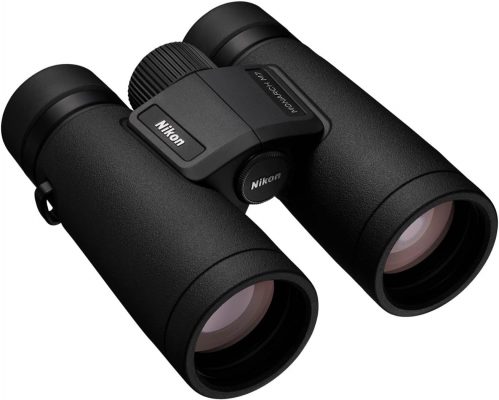
The Nikon Monarch 7 (8×42) stands out as a premier choice for nature enthusiasts who demand both high performance and reliability in their optical equipment. Here’s a closer look at what makes this model a top contender in the field of binoculars.
Conclusion: The Nikon Monarch 7 (8×42) is an excellent choice for anyone looking for a high-quality binocular that combines stellar optics, rugged durability, and user-friendly features. It’s particularly suited for bird watchers and wildlife observers who require precision and reliability in diverse environmental conditions. Whether you’re scanning the horizon or zooming in on a rare species, the Monarch 7 is designed to enhance every visual experience with exceptional clarity and comfort.
Optical Excellence: The Monarch 7 features Nikon’s advanced optical system, which includes ED (Extra-low Dispersion) glass. This technology significantly reduces chromatic aberration, delivering images with superb contrast, vivid color, and sharper details. The fully multi-coated eco-glass lenses ensure excellent light transmission, resulting in brighter views even in low-light conditions.
Build Quality and Durability: Built to endure the harsh realities of outdoor use, the Monarch 7 boasts a rugged, rubber-armored coating that provides a non-slip grip even in wet conditions. It is nitrogen-filled and O-ring sealed, making it completely waterproof and fog-proof. This durability makes it a reliable companion for any outdoor adventure, from rainy birdwatching sessions to dewy morning hikes.
User-Friendly Features: With a user-centric design, the Monarch 7 offers a smooth central focus knob that makes it easy to bring objects into sharp focus quickly. The turn-and-slide rubber eyecups allow for comfortable viewing during extended periods, accommodating both eyeglass wearers and non-wearers with equal ease.
Field of View: One of the standout features of the Monarch 7 is its wide field of view, which is particularly beneficial for tracking fast-moving wildlife. At 1000 yards, users can enjoy a panoramic view of 420 feet, making it easier to spot and follow birds as they fly or wildlife as they move through brush.
Portability: Despite its robust construction and large 42mm lenses, the Monarch 7 remains relatively lightweight at just under 23 ounces. This makes it manageable for all-day carry during lengthy field trips or casual nature walks.
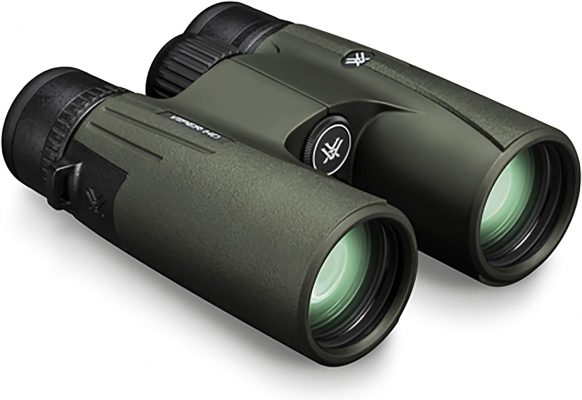
The Vortex Optics Viper HD (10×42) is a high-performance binocular that has garnered praise from serious outdoor enthusiasts and professionals alike. Designed for those who require clear, precise imaging in a rugged, field-ready package, the Viper HD offers exceptional features and reliability.
Conclusion: Overall, the Vortex Optics Viper HD (10×42) is an excellent choice for anyone looking for top-tier optics combined with extreme durability and user-friendly features. Whether you’re a hunter tracking game through dense forests or a bird watcher needing high-definition views, the Viper HD provides performance that won’t disappoint.
Optical Performance: The Viper HD models come equipped with High Density (HD) extra-low dispersion glass which provides impressive resolution and color fidelity. The optics are fully multi-coated, maximizing light transmission and reducing glare to produce sharp, bright images even under challenging light conditions. The 10x magnification brings distant objects into clear focus, making these binoculars ideal for detailed observation of distant subjects.
Build and Durability: Vortex is known for its commitment to quality and durability, and the Viper HD is no exception. It features a rubber-armored chassis with ArmorTek coating that protects the exterior lenses from scratches, oil, and dirt. The binoculars are also argon purged and O-ring sealed, ensuring they remain waterproof and fog-proof, which is crucial for maintaining performance in humid or wet environments.
Ergonomics and Ease of Use: Despite its robust build, the Viper HD is surprisingly lightweight and comfortable to hold for extended periods, thanks to its ergonomic design. The adjustable eyecups twist up and down to precise, intermediate settings to provide a custom fit for comfortable viewing with or without eyeglasses. The center focus wheel adjusts smoothly, allowing for quick and easy focusing on moving or stationary targets.
Field of View: The Viper HD offers a generous field of view of 319 feet at 1000 yards, which is beneficial for covering large areas when scanning for wildlife or during sporting events. This wide field makes it easier to locate and track subjects without needing to move the binoculars frequently.
Warranty and Service: One of the standout features of Vortex products is their VIP Warranty, which is a lifetime, unconditional, transferable warranty that promises to repair or replace the product at no cost to the customer. This warranty adds immense value and peace of mind, underscoring Vortex’s commitment to customer satisfaction.
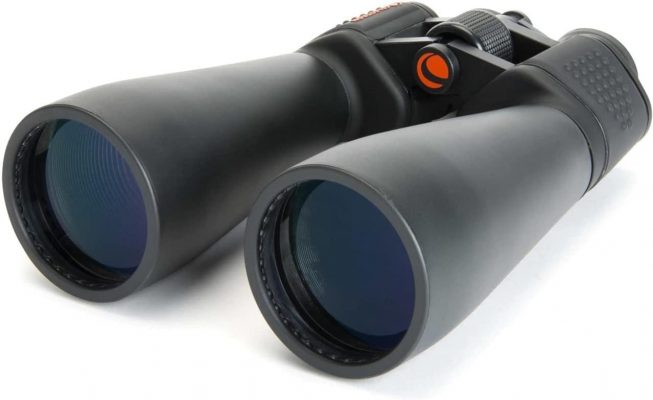
The Celestron SkyMaster Giant (15×70) binoculars are a standout choice for amateur astronomers and long-distance terrestrial observers who demand powerful magnification paired with large aperture lenses. Here’s what makes the SkyMaster Giant a preferred option for those who aim to explore the skies or distant horizons.
Conclusion: The Celestron SkyMaster Giant (15×70) is an exceptional choice for anyone looking to delve into astronomy or who needs powerful magnification for long-distance terrestrial viewing. They provide remarkable optical performance at an accessible price point, making them a popular option among both beginners and experienced observers looking to expand their viewing capabilities.
Optical Performance: The SkyMaster Giant features large 70mm objective lenses that capture a significant amount of light, making them ideal for low-light conditions and night-time viewing. The 15x magnification provides detailed, up-close views of celestial bodies and distant landscapes. These binoculars utilize BaK-4 prisms and multi-coated optics to enhance contrast and resolution, ensuring clear and bright images.
Design and Build: Given their large size, the SkyMaster Giant is designed with both durability and comfort in mind. The rugged exterior provides a secure grip, while the included tripod adapter allows for easy attachment to a tripod, crucial for stabilizing the view at high magnifications. Despite their robust build, they are surprisingly manageable for hand-held use during short viewing sessions.
Ease of Use: These binoculars feature a long eye relief, making them comfortable for eyeglass wearers, and the large focus dial is easy to adjust, even with gloved hands. This makes them particularly user-friendly in various observing conditions, from chilly nights watching stars to sunny days observing distant ships at sea.
Field of View: The SkyMaster Giant offers a relatively narrow field of view at 231 feet at 1000 yards, which is typical for high-magnification binoculars. While this narrower field requires more precise aiming to locate objects, the depth and detail of the view are well worth the extra effort.
Versatility and Applications: While primarily designed for astronomical viewing, the SkyMaster Giant is also excellent for other long-distance observation needs, such as spotting wildlife or surveilling expansive landscapes.

The Bushnell H2O Waterproof/Fogproof (10×42) binoculars are tailored for outdoor enthusiasts who face diverse weather conditions and need reliable, rugged optics. Here’s a closer look at how these binoculars stand up to the elements while providing excellent visual performance.
Conclusion: The Bushnell H2O Waterproof/Fogproof (10×42) is an excellent choice for adventurers who need durable and reliable optics capable of performing in a variety of environmental conditions. Whether you’re kayaking, hiking in misty weather, or enjoying a rainy day at a sporting event, these binoculars will provide a clear and enjoyable viewing experience. Their combination of features and affordability also makes them a popular choice among casual and serious outdoor enthusiasts alike.
Optical Performance: Equipped with 10x magnification and 42mm objective lenses, the Bushnell H2O offers a good balance between power and brightness, making it suitable for a variety of outdoor activities. The optics feature BaK-4 prisms and multi-coated lenses which enhance clarity and light transmission, providing bright and clear views even in challenging lighting.
Durability and Build: True to their name, the Bushnell H2O binoculars excel in water resistance. They are O-ring sealed and nitrogen purged to ensure they remain waterproof and fog-proof, which is essential for use near water or in humid conditions. The non-slip rubber armor not only provides a firm grip but also absorbs shock, protecting the binoculars from rough handling.
Ergonomics and Comfort: These binoculars are designed with user comfort in mind, featuring twist-up eyecups that adjust for personal comfort and to accommodate eyeglass wearers. The large center-focus knob is easy to adjust, allowing for smooth and precise focusing, which is especially useful when observing fast-moving subjects.
Field of View: With a field of view of 305 feet at 1000 yards, the Bushnell H2O provides a decent range for observing expansive areas, making them ideal for bird watching, boating, or sporting events.
Portability: Despite their robust construction, the Bushnell H2O binoculars remain relatively lightweight and compact, making them easy to carry around the neck or in a backpack during long treks or trips.
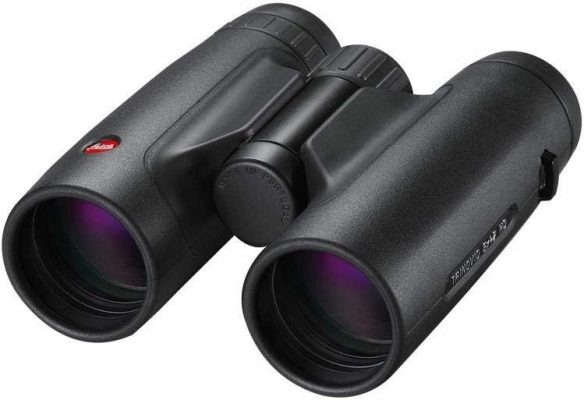
The Leica Trinovid HD (10×42) binoculars represent a blend of exceptional optical performance and practical, rugged design, making them a favorite among discerning outdoor enthusiasts and wildlife observers. Here’s what sets the Trinovid HD apart in the competitive field of high-end optics.
Conclusion: The Leica Trinovid HD (10×42) is an excellent investment for anyone looking for top-tier binoculars that combine superb optical quality with a durable, user-friendly design. Whether you’re a birdwatcher, a hunter, or an outdoor adventurer, the Trinovid HD offers the performance and reliability expected from a brand like Leica, ensuring every visual experience is as vivid and detailed as possible.
Optical Excellence: The Leica Trinovid HD is renowned for its high-definition optics that offer outstanding color fidelity and image sharpness. With 10x magnification and 42mm objective lenses, these binoculars provide a well-balanced combination of detail and light gathering capability. The lenses are treated with Leica’s innovative HDC coatings, which enhance light transmission and provide excellent contrast and image clarity, even in low-light conditions.
Build Quality and Durability: Designed to withstand the demands of the great outdoors, the Trinovid HD features a rugged, rubber-armored body that ensures durability and provides a non-slip grip. These binoculars are also waterproof and dustproof, capable of withstanding harsh weather conditions without compromising performance.
Ergonomic Design: Leica focuses heavily on user comfort and efficiency. The compact form factor of the Trinovid HD makes them easy to handle during extended periods of use. The ergonomic design includes intuitively placed focus and diopter adjustment wheels that are easily accessible for quick, precise adjustments.
Field of View: Offering a field of view of 339 feet at 1000 yards, the Trinovid HD allows for expansive viewing, making it easier to track moving subjects such as birds or wildlife. This wide field of view combined with the smooth focusing mechanism makes them highly effective for dynamic outdoor activities.
Portability and Accessories: The Trinovid HD models are relatively lightweight for their class, and Leica includes practical accessories such as a durable carrying strap and a protective case. The innovative Adventure Strap, which doubles as a carrying solution and protective cover, provides added convenience and protection on the go.

The Zeiss Terra ED Compact (8×25) is a high-quality binocular that provides exceptional optical clarity in a small, travel-friendly package. Ideal for hikers, bird watchers, and frequent travelers, here’s what makes the Terra ED Compact a standout choice.
Conclusion: The Zeiss Terra ED Compact (8×25) is an excellent choice for anyone needing a high-performance, lightweight binocular that can be easily transported and used on the go. Its superior optics, combined with a user-friendly design, make it a great investment for casual observers and serious enthusiasts who demand quality without the bulk. Whether you’re heading out for a nature walk, attending a sports event, or traveling, these binoculars will ensure you don’t miss a detail.
Optical Performance: Despite its compact size, the Terra ED does not compromise on the quality of vision. It features 8x magnification and 25mm objective lenses with Extra-low Dispersion (ED) glass, which reduces chromatic aberration and enhances color accuracy. The lenses are fully multi-coated, improving light transmission and providing bright, clear images even in dim conditions.
Build and Portability: The Terra ED Compact is specifically designed for portability and ease of use on the move. Its lightweight design, weighing just over 10 ounces, makes it one of the lightest in its class. The robust construction ensures durability and resilience to environmental factors, making it a reliable companion for rugged outdoor use.
Ease of Use: These binoculars feature a smooth and easy-to-operate focus wheel that allows for quick adjustments. The compact size fits comfortably in one hand, and the ergonomic design makes it easy to maintain a steady view, even with the high level of magnification provided.
Field of View: With a field of view of 390 feet at 1000 yards, the Terra ED Compact offers a wide viewing angle, making it easier to scan large areas and track moving objects such as birds or wildlife. This wide field is particularly useful in dynamic environments where action is continuous and unpredictable.
Special Features: The Terra ED Compact also benefits from hydrophobic multi-coated lenses, which repel water and resist fogging. This makes them particularly suitable for use in all weather conditions, ensuring that your viewing experience is not interrupted by rain or sudden temperature changes.
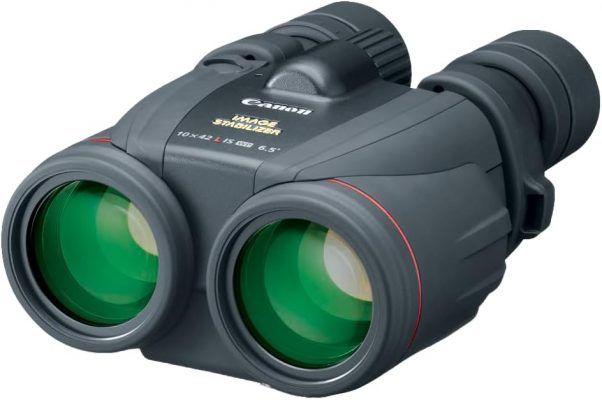
The Canon Image Stabilized All-Weather (10×30) binoculars are a unique offering in the market, combining Canon’s renowned image stabilization technology with a versatile, all-weather design. Ideal for both casual users and avid observers who encounter dynamic and challenging environments, here’s why these binoculars stand out.
Conclusion: The Canon Image Stabilized All-Weather (10×30) is an excellent choice for anyone looking for a high-performance, stabilized binocular that can handle less-than-ideal weather conditions. Whether you’re watching wildlife, enjoying a scenic hike, or attending a sporting event, these binoculars ensure a clear, stable view in various settings. Their lightweight and durable design, combined with innovative stabilization, make them a valuable tool for enhancing your observational experiences.
Optical Performance: The 10x magnification provides excellent detail for distant subjects, while the 30mm objective lenses ensure adequate light gathering to maintain bright images. What sets these binoculars apart is Canon’s image stabilization (IS) technology, which effectively reduces hand shake and movement, resulting in a stable and clear viewing experience without the need for a tripod.
Build and Weather Resistance: Designed to be durable and dependable in various weather conditions, these binoculars are built with water-resistant materials that protect against light rain and moisture. While not fully waterproof, they are well-suited for most outdoor activities where sudden changes in weather might be a concern.
Ease of Use: The IS feature is activated with a simple press of a button, instantly stabilizing the image and making it easier to focus on moving or distant subjects. The compact and ergonomic design fits comfortably in the hands, and the overall weight is manageable for extended use, minimizing user fatigue.
Field of View: The field of view is 314 feet at 1000 yards, which is quite generous for binoculars equipped with image stabilization. This allows users to enjoy a broad visual area, making it easier to track fast-moving sports, wildlife, or panoramic landscapes.
Battery Dependency: One consideration is that the image stabilization feature is battery-operated, requiring two AA batteries. While this adds a slight dependency, the benefits of stabilized viewing often outweigh the inconvenience for many users.
Care and Maintenance Tips for Binoculars 🔧
Proper care and maintenance of your binoculars can significantly extend their lifespan and ensure they continue to provide high-quality performance. Here are some essential tips to help you take the best care of your optical investment:
1. Handling and Storage
- Handling: Always hold your binoculars by the body to avoid smudging the lenses. Use the neck strap to prevent accidental drops.
- Storage: Store your binoculars in a dry, cool place to prevent mold and fungus growth. Use the protective case provided to shield them from dust and scratches. For long-term storage, consider using silica gel packets to absorb any excess moisture in the storage area.
2. Cleaning the Lenses
- Regular Dusting: Use a soft brush or a specialized optical brush to gently remove dust or sand from the lens surfaces. Avoid using your fingers or rough materials that could scratch the lenses.
- Smudge Removal: To clean fingerprints or oil, use a microfiber cloth or a lens cleaning tissue. Apply a small amount of lens cleaning solution or isopropyl alcohol to the cloth (not directly on the lenses) and gently wipe in a circular motion.
- Avoid Harsh Chemicals: Never use household glass cleaners or other harsh chemicals to clean your binocular lenses. These can strip away the coatings and damage the optics.
3. Lens Protection
- Lens Caps: Always replace the lens caps when you are not using your binoculars. This prevents accidental scratches and keeps the lenses clean.
- Avoid Direct Sunlight: Never leave your binoculars where direct sunlight can enter the lenses. Prolonged exposure to sunlight can cause damage to the internal components and may lead to the formation of condensation when moved to cooler environments.
4. Moisture and Fungus Prevention
- Waterproof Models: If your binoculars are not waterproof, avoid using them in the rain or high humidity conditions. If they do get wet, dry them thoroughly as soon as possible.
- Fungus Issues: If you notice any signs of fungus or mold, it’s crucial to have your binoculars cleaned professionally to prevent further damage.
5. Regular Inspections
- Alignment Checks: Regularly check the alignment of your binoculars by viewing a distant straight edge (like a rooftop or a telephone pole). Misalignment can cause double images or eye strain.
- Screw Tightening: Occasionally check and tighten any loose screws on the body of the binoculars. Loose parts can lead to internal misalignments or other mechanical issues.
6. Professional Servicing
- Periodic Maintenance: Even with good home care, consider having your binoculars professionally serviced every few years, especially if used frequently in rough conditions. This can include deep cleaning, lubrication, and alignment adjustments, ensuring that your binoculars remain in top condition.
By following these care and maintenance tips, you can protect your investment and enjoy the benefits of your binoculars for many years. Proper maintenance not only preserves the quality and performance of your binoculars but also ensures that every viewing experience is as impressive as the first.
Understanding Binocular Specifications Explained 🧐
When shopping for binoculars, you’ll encounter various technical specifications that can seem confusing at first glance. Understanding these specs is crucial for choosing the right binoculars for your needs. Here’s a breakdown of the most common terms and what they mean for your viewing experience:
Magnification and Objective Lens Diameter
- Magnification (Power): This number, such as 8x or 10x, indicates how many times closer the viewed object appears compared to the naked eye. Higher magnifications offer closer views but can make the binoculars harder to hold steady.
- Objective Lens Diameter: Measured in millimeters (mm), this number follows the magnification in binocular descriptions (e.g., 8×42). It represents the diameter of the front lenses. Larger lenses allow more light to enter, improving the image brightness and clarity, especially in low-light conditions.
Field of View (FOV)
- Definition: The field of view is the width of the area you can see at a distance of 1,000 yards or meters. It is usually measured in feet or meters. A wider FOV makes it easier to track moving objects and provides a more immersive viewing experience.
Prism Type
- Porro Prisms: Characterized by a zigzag design that separates the objective lens from the eyepiece. Porro prism binoculars generally offer a greater depth of field and wider field of view but are bulkier.
- Roof Prisms: These have a straight-line design, aligning the lenses directly with the eyepiece, which allows for a more compact and streamlined shape. They are typically more lightweight and less cumbersome, ideal for hiking or extensive travel.
Lens Coatings
- Coated Lenses: A single layer applied to at least one lens surface to reduce light loss and glare, resulting in clearer, brighter images.
- Multi-Coated Lenses: Multiple layers are applied to one or more surfaces to increase light transmission.
- Fully Multi-Coated Lenses: All air-to-glass surfaces have multiple coatings, providing the best light transmission and brightest, clearest images.
Eye Relief
- Eye Relief: The distance from the last surface of an eyepiece within which the user’s eye can obtain the full viewing angle. Longer eye relief (typically more than 15mm) is better for eyeglass wearers as it allows them to see the entire field of view without having to remove their glasses.
Waterproof and Fogproof Capabilities
- Waterproofing: This feature prevents moisture from entering the binoculars, crucial for use in damp conditions.
- Fogproofing: Achieved by filling the binocular chambers with inert gases like nitrogen or argon to prevent internal fogging caused by temperature changes.
Exit Pupil
- Exit Pupil: The size of the light beam visible through the eyepiece, calculated by dividing the objective lens diameter by the magnification (e.g., a 7mm exit pupil in 7×50 binoculars). A larger exit pupil makes it easier to maintain a full image if your hands move, and enhances performance in low-light conditions.
This guide to understanding binocular specifications will help you navigate the details of different models and make an informed decision based on your specific needs and intended use. Whether you’re bird watching, stargazing, or attending sporting events, knowing these specs will enhance your ability to choose the perfect pair of binoculars.
Frequently Asked Questions (FAQs)
Here are some of the most commonly asked questions about binoculars, providing quick, clear answers to help enhance your understanding and decision-making process:
1. What does the binocular number code mean, like 10x42?
The number code on binoculars, such as 10×42, describes two key specifications. The first number (10x) indicates the magnification power, meaning objects appear ten times closer than they do to the naked eye. The second number (42) is the diameter of the front lenses in millimeters, which affects the amount of light that enters the binoculars, influencing brightness and clarity of the image.
2. How do I choose between Porro prism and roof prism binoculars?
Choose Porro prism binoculars if you want a wider field of view and greater depth perception at a potentially lower cost but don’t mind the extra bulk. Opt for roof prism binoculars if you need something more compact and easier to carry, ideal for hiking or long travels, though they might be more expensive.
3. Can I use binoculars if I wear glasses?
Yes, look for binoculars with high eye relief (the distance between the eyepiece and your eye) of at least 15mm. This specification allows you to see the entire field of view without removing your glasses. Binoculars with adjustable eyecups are also beneficial as they can be twisted up or down for better comfort.
4. What are fully multi-coated lenses, and why are they important?
Fully multi-coated lenses have multiple layers of anti-reflective coating on all air-to-glass surfaces. These coatings significantly increase light transmission, reduce glare, and provide clearer and brighter images. They are especially important in low-light conditions or when observing subjects against strong backlighting.
5. Are more expensive binoculars always better?
Not necessarily. While higher-priced binoculars often feature advanced optics and superior build quality, mid-range or budget binoculars can also provide excellent value and performance, especially for casual users. It’s important to assess whether the features of more expensive models align with your specific needs before making an investment.
6. How do I maintain my binoculars to ensure they last a long time?
Regular maintenance includes storing your binoculars in a cool, dry place, using lens caps, cleaning the lenses with a proper lens brush and microfiber cloth, and avoiding harsh chemicals. It’s also advisable to have them professionally serviced every few years, especially if frequently used in rugged conditions.
7. What does it mean if binoculars are fogproof and waterproof?
Waterproof binoculars are sealed to prevent moisture from entering the interior, making them suitable for use in wet conditions. Fogproof binoculars are filled with inert gases like nitrogen or argon to prevent internal fogging, which can occur due to temperature changes. Both features enhance the durability and versatility of binoculars under various environmental conditions.
Conclusion: Enhancing Your Viewing Experience with the Right Binoculars 🌟
Choosing the right pair of binoculars can dramatically enhance your viewing experiences, whether you’re observing wildlife, attending a sports event, or exploring the stars. Throughout this guide, we’ve covered the essentials from why high-quality binoculars are a worthwhile investment to detailed reviews of some of the top models on the market. We’ve also unpacked the key features to consider when shopping for binoculars and provided practical advice on maintenance to ensure your binoculars last.
High-quality binoculars bring objects into clearer view with greater detail, offer durable construction to withstand various environments, and include ergonomic features for comfortable, extended use. By understanding the technical specifications, like magnification, objective lens diameter, and lens coatings, you can make an informed choice that matches your specific needs.
Remember, the best binoculars for you depend on your intended use—whether it’s bird watching, stargazing, or any other activity. Considerations like the environment where you’ll be using them, your budget, and the portability required should guide your decision. Reviews and recommendations, like those provided here, can offer valuable insights from experienced users, helping you narrow down your choices.
In conclusion, investing in the right binoculars is about enhancing your ability to connect with the world around you in a more detailed and immersive way. With the right pair, every look through the lenses can be a discovery, transforming how you see and interact with your surroundings. Armed with the knowledge from this guide, you’re now equipped to choose the perfect binoculars that will open up new vistas and bring distant wonders within clear view.
